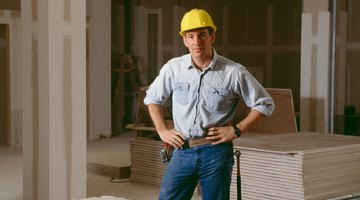Advantages & Disadvantages of Using Drywall
When you build or remodel a home, you have many decisions to make. Some, like paint color and curtain fabric, are easily changed when you tire of them. Other decisions, such as which building material to use for your walls, are much more permanent, so it’s important to consider your options before making your choice.

Installation
One big advantage of drywall is that it is faster and easier to install than traditional plaster. Traditional plaster requires a skilled plasterer to apply three coats of plaster over a framework of lath strips. Do-it-yourselfers, on the other hand, can install drywall on their own and find a local professional to complete the taping and finishing. Do not attempt to do this part of the task on your own unless you are experienced.
A disadvantage to drywall is its weight. A standard 4-by-8 sheet of 1/2-inch drywall weighs more than 50 lbs. This means either you need a partner to help you move and install it or you need to pay to have it delivered and use a machine called a drywall jack to install ceiling panels if you are working on a ceiling. Another disadvantage to drywall is that it is not as flexible as plaster, so drywalling curved surfaces is challenging and may not achieve the desired results.
Durability
Drywall is more stable than plaster, but it is not as durable. Drywall is thinner and has joints -- plaster does not -- making it more prone to dents and holes, but drywall is easy to repair. Use a drywall patch or joint compound to fill in dents.
Another benefit of drywall is that it is fire-resistant because it is made of a mineral called gypsum. Plaster is also fire-resistant, making both choices better than other building materials.
Appearance
There are a couple of potential disadvantages to drywall when it comes to appearance. If the finisher does not tape them properly, the joints between sheets may be visible. This is why it is so important to hire a professional finisher.
Also, drywall cannot give a handcrafted look. While this probably doesn’t concern most homeowners, it will matter if you are trying to restore a home from the early 1900s and want to retain that authentic look.
Considerations

Choose the right wallboard for the job. Drywall typically comes in sheets that are 4 feet wide. Length varies from 8 to 16 feet, with thickness varying between 1/4 and 5/8 of an inch.
Choose moisture-resistant drywall -- often referred to as “greenboard” because it is green -- for humid areas such as bathrooms and laundry rooms. If you are concerned about mold, consider a mold-resistant drywall. This wallboard is also moisture-resistant but gives you added protection against the growth of mold and mildew.
The Drip Cap
- When you build or remodel a home, you have many decisions to make.
- Do-it-yourselfers, on the other hand, can install drywall on their own and find a local professional to complete the taping and finishing.
- A standard 4-by-8 sheet of 1/2-inch drywall weighs more than 50 lbs.
- Another disadvantage to drywall is that it is not as flexible as plaster, so drywalling curved surfaces is challenging and may not achieve the desired results.
- Drywall is thinner and has joints -- plaster does not -- making it more prone to dents and holes, but drywall is easy to repair.
- Use a drywall patch or joint compound to fill in dents.
References
Resources
- “Black & Decker Working with Drywall”; Editors of Creative Publishing International; 2009
- National Gypsum: The Facts about National Gypsum Drywall -- Benefits
Writer Bio
Jennifer Loomis is a certified English/language arts teacher and is a writer of teaching and literature materials. She also specializes in writing home and garden articles. Loomis holds a B.A. in philosophy from Mount Mary College, a secondary English teaching certification from the University of Wisconsin Green Bay and a master's degree in English from the University of Wisconsin Oshkosh.
Photo Credits
- Jupiterimages/Photos.com/Getty Images
- Jupiterimages/Photos.com/Getty Images
- Jupiterimages/Photos.com/Getty Images
More Articles



